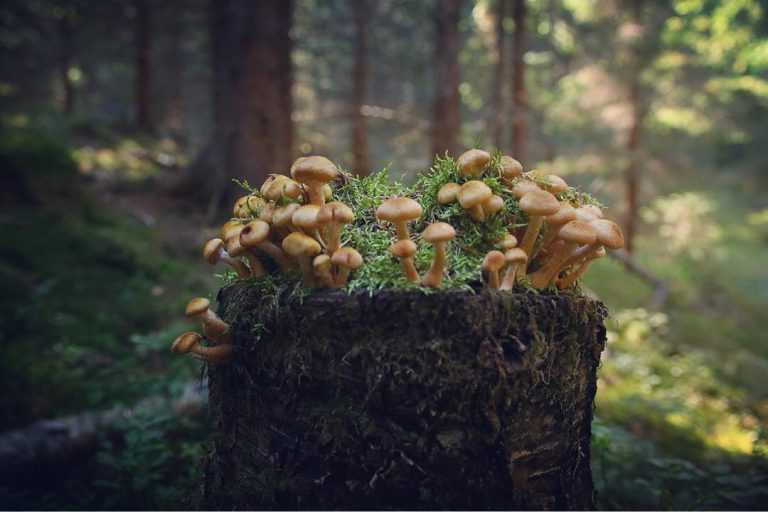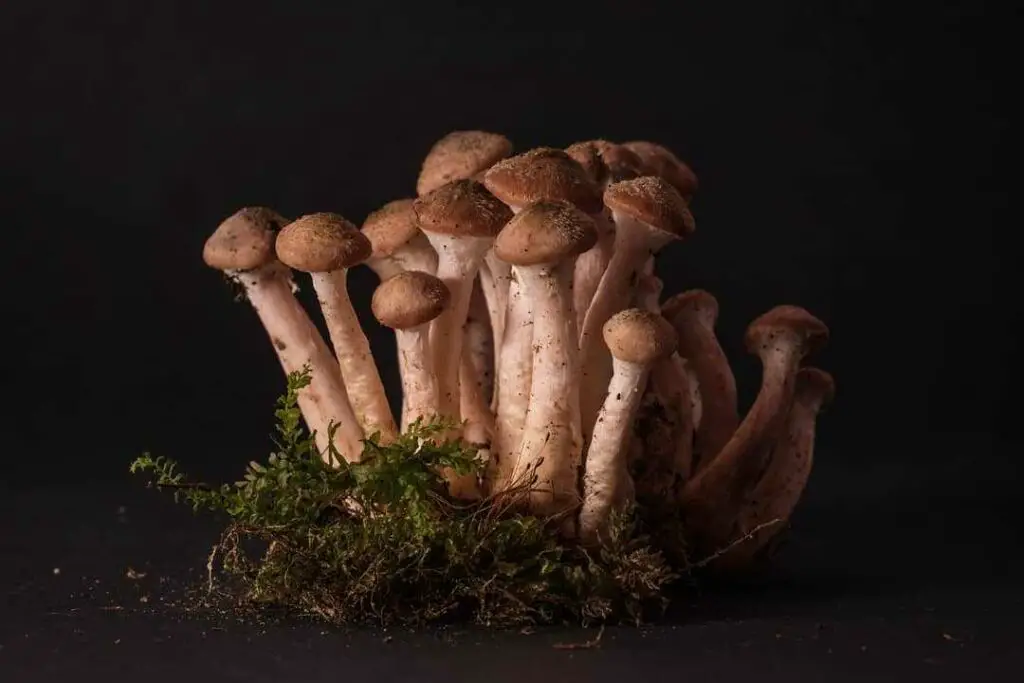Autumn honey agaric (Armillaria mellea) is a conditionally edible mushroom; it is not eaten without additional processing. It has excellent taste quality. The mushroom owes its name to the habitat “about the stump”, that is, next to the stump.

Among the people, under the name “honey mushroom or armillaria mellea”, about a dozen mushrooms of the genus Agaric are combined. And they are often called by the color of the hat (honey, light, dark) or the place and time of growth (birch, oak, meadow, summer, autumn). In some regions, mushrooms are not collected at all, it is not accepted. And unlike mushrooms, “efficient” ones are referred, together with others, to the offensive category of “toadstools”.
Detail about Mushroom Family.
Table of Contents
Armillaria mellea identification, Characteristics, and appearance
The hat of the armillaria mellea is round and convex, light from the edges and darker towards the center, covered with scales. Skin to deep brown color. In young mushrooms, the cap is almost spherical in shape and fits snugly to the stem.
From below it is covered with a velum (skirt), which is torn from the growth of the fungus and the opening of the cap. As it matures, the cap brightens, straightens, and in old mushrooms, it can be almost even or with edges turned up.
Mushroom lamellar. Spore-bearing plates are frequent, almost white in young mushrooms, darker with brown spots in mature mushrooms. The plates are brittle and break easily.
The stem is oriented vertically, but more often it is curved in the most incredible way. armillaria mellea grows in a bunch from one point.
The stem is similar to a spindle, fibrous and relatively thin, up to 1–1.5 cm, slightly thickened at the bottom. The color of the stem varies from dark brown at the bottom to light brown under the cap.
Armillaria mellea glow is white in various shades. In young mushrooms of sufficient thickness, as the mushroom grows, the flesh on the cap becomes thinner. The leg has a white, dense, and uniform in color flesh. The structure is fibrous and dense but is easily separated into individual fibers. It becomes hard in mature mushrooms, as well as when harvested by drying.
Spore powder of intense white color, ellipsoid spores 8.5×5.5 µm in size. The powder is clearly visible on overripe mushrooms in the form of a white coating on the caps. In dry weather, if you touch such a family, a cloud of spores rises.
Mushroom with a pleasant taste and fragrant mushroom smell. armillaria mellea is significantly affected by worms. Only specimens without a wormhole are suitable for collection and harvesting.
Armillaria mellea Characteristics:
| Group: | lamellar |
|---|---|
| Records: | white color |
| Colour: | Nude, brown |
Armillaria mellea identification
| The Department: | Basidiomycota (Basidiomycetes) |
|---|---|
| Subdivision: | Agaricomycotina (Agaricomycetes) |
| Class: | Agaricomycetes (Agaricomycetes) |
| Subclass: | Agaricomycetidae (Agaricomycetes) |
| Order: | Agaricales (Agaric or Lamellar) |
| Family: | Physalacriaceae (Physalacriae) |
| Genus: | Armillaria (Agaric) |
| View: | Armillaria mellea (Autumn honey agaric) |
Here is Lactarius indigo guide.
Armillaria Mellea look alikes
armillaria mellea look alikes image.

where does honey fungus come from? habitat
The honey mushroom or armillaria mellea is known everywhere. It has the widest range from the tropics to the Far North and in all time zones.
It grows in mixed and deciduous forests, preferring birch. If the forest land is more than 30 years old, then you can probably collect mushrooms there. Often found in the root zone of bird cherry and viburnum, in thickets of hazel and acacia.
Armillaria mellea rarely parasitizes on a living tree, and mainly settles on stumps and dead trunks. It performs sanitary functions; in a few years, wood and hemp, seeded with mycelium, turn into dust. In harvest years, it can also grow on leafy litter or even in the grass. Especially if earlier a tree or its branches lay here and a woody substrate was still preserved in the soil.
Armillaria mellea Fruiting and harvesting
Fruiting begins in late August and continues until the first frost. It proceeds in waves, as a rule, a more productive first wave, which lasts one to two weeks. Then there is a break of several weeks and everything repeats.
A mushroom with a cap diameter of 2 to 7 cm is considered to be marketable, small ones are simply a pity to cut, and larger specimens are of little use for food and have no nutritional value. Experienced mushroom pickers do not take mushrooms with a fully opened hat and spores covered with white bloom.
Experienced mushroom pickers and gardeners successfully grow Armillaria mellea on their plots along with oyster mushrooms. Blocks of deciduous trees are used for sowing spores. Sowing is done with water infused with old, spore-bearing mushrooms or gruel prepared from them.
are all armillaria edible?
In nature, there are several dozen species of fungi related to autumn honey mushroom or mushrooms similar to it. Most of them are collected in one basket under the general name “honey mushrooms”. You can confuse the autumn (real) honey mushroom with mushrooms of the genus flake. Of which only Golden Scale is conditionally edible, while the rest are not poisonous. They are simply inedible and have a rich bitter taste. Once in the dish, the mushroom will simply ruin the dinner, but will not harm your health.
The poisonousness of the false honey mushroom, which everyone is afraid of, is also greatly exaggerated. In case of an error, the effect will be similar to a flake.
It is difficult to make a mistake if you know the signs of false mushrooms:
- cap color from light to intense yellow;
- hat without scales;
- thin and completely smooth leg, also without scales;
- lack of a velum skirt;
- bitter taste and unpleasant, repulsive smell.
We must not forget the basic rule of the mushroom picker or neglect it. “If you don’t know, don’t take it; if you’re not sure or have doubts, don’t take it.”
Confusing these mushrooms with autumn honey mushrooms is very difficult, almost impossible.
We have prepared a guide on Black Truffle Mushroom with types and pictures.
Armillaria mellea benefits and valuable qualities
In the kitchen, honey mushroom takes its rightful place. Experienced housewives prepare many dishes from it. Soups and main dishes are prepared with mushrooms, they are fried, salted, and marinated. Honey mushrooms are harvested for future use by drying or deep freezing.
The mushroom has a valuable nutritional and taste quality. The autumn mushroom is rich in vitamins: A, B2, B3, and B6. It has an increased content of trace elements: iron, potassium, magnesium, zinc, copper, and many polysaccharides. The armillaria mellea is used in folk medicine and official pharmacology.
Before any cooking, all mushrooms and mushrooms, in particular, must be boiled and drained. With dried mushrooms or after defrosting, they do the same.
Conclusion
In conclusion, Armillaria mellea is a safe and edible mushroom that can be found in the wild. It has many health benefits and can be added to various dishes. If you are looking for a new and interesting mushroom to add to your collection, Armillaria mellea is a great choice.